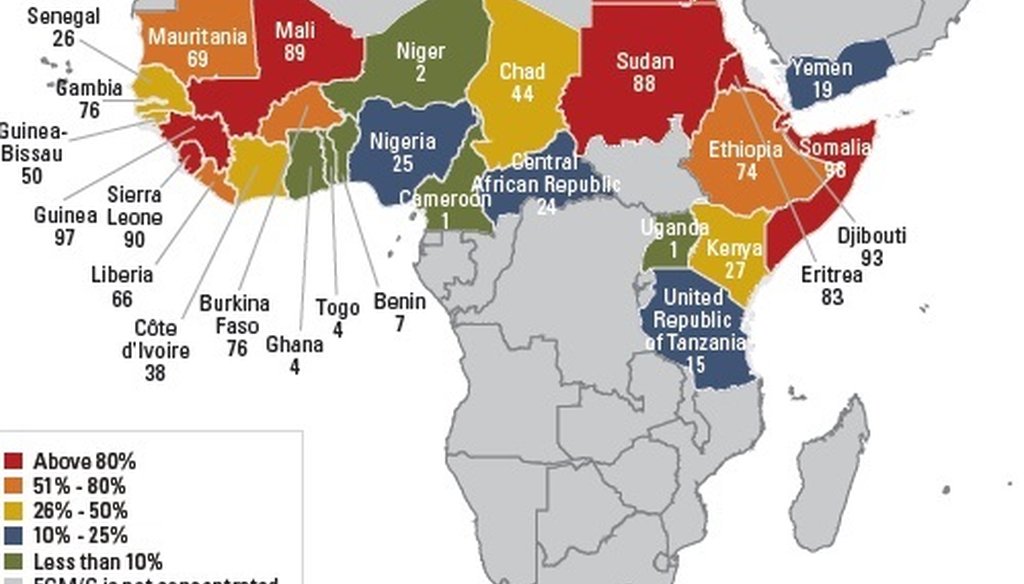Stand up for the facts!
Our only agenda is to publish the truth so you can be an informed participant in democracy.
We need your help.
I would like to contribute

Reza Aslan tweeted this map from a UNICEF report to bolster his point about female genital mutilation being a "central Africa," and not Islamic, problem.
After publishing our fact-check of religion scholar Reza Aslan about the issue of female genital mutilation, we heard from several readers questioning part of Aslan’s statement.
Aslan had claimed female genital mutilation is not "an Islamic problem," as Bill Maher suggested on his HBO show, but a "a central African problem." When CNN hosts asked Aslan about Maher, who singled out high prevalence rates in Muslim-majority countries Egypt and Somalia, Aslan said:
"It's a central African problem. Eritrea has almost 90 percent female genital mutilation. It's a Christian country. Ethiopia has 75 percent female genital mutilation. It's a Christian country. Nowhere else in the Muslim, Muslim-majority states is female genital mutilation an issue."
We rated Aslan’s claim that this practice is not solely an Islamic problem Mostly True, noting the centuries-old practice is widely documented in a strip of primarily African countries that are majority-Muslim and also majority-Christian. Also, the Koran does not specifically require this practice, but there is division among the world’s 1.6 billion Muslims about whether it should be performed.
Put another way, we focused on the fact that female genital mutilation is not entirely a Muslim problem, since it occurs at high rates in non-Muslim countries.
Sign up for PolitiFact texts
Readers asked us to look at Aslan's claim through another lens: Is female genital mutilation isolated in central Africa, or does it occur in other places around the world?
We ultimately decided not to publish our expanded research as a fact-check -- partly because it feels like a bit of double jeopardy, and partly because we addressed this very point in our earlier work. (We noted that Aslan acknowledged some may object to his "central African" characterization and that UNICEF and international groups consider it a "global" problem since it happens in parts of Asia, Europe and North America.)
But we did expand our work so readers might have a fuller view.
* * *
Weeks ago, Aslan tweeted an infographic from a July 2013 UNICEF report to support his point that female genital mutilation is a central African problem.
This map shows the percentage of girls and women ages 15-49 who have undergone female genital mutilation in 27 African countries and two Middle Eastern countries where UNICEF said the practice is concentrated. African countries with "almost universal" levels of FGM were Somalia, Egypt, Guinea and Djibouti, all with rates of 93 percent or higher. Almost half of the countries on this list were not majority-Muslim.
The two Middle Eastern countries, Yemen and Iraq, have much lower prevalence rates of 23 percent and 8 percent, respectively. In Iraq, the report says, it is practiced mainly by Kurds in the northern region towns of Erbil and Sulaymaniyah and is not happening elsewhere.
Other majority-Muslim countries in the Middle East, such as Saudi Arabia and Iran, as well as Southeast Asia are not listed.
"It is extremely clear that in many countries that have a very high population of Muslims, female genital mutilation/cutting is not practiced," Francesca Moneti, the UNICEF senior child protection specialist who co-authored the report, told us recently.
That boosts Aslan’s point.
However, as we noted in our original work, UNICEF considers the practice a "global issue" that affects communities in Europe, Asia (including the Middle East) and North America, largely because of immigration.
The report says, "The practice is found to a far lesser degree in other parts of the world, though the exact number of girls and women affected is unknown."
* * *
Some readers emailed us with concerns about the UNICEF report. It is considered among governmental organizations like the U.S. Agency for International Development to be thorough and relies on data based on nationally representative samples.
That said, there are critics.
Hannah Wettig, who manages the Stop FGM Middle East campaign for Germany-based nonprofit WADI and Hivos, pushes back on the notion of FGM as an "African problem" and criticized UNICEF’s reliance on national survey data. For one, she said, Middle Eastern women may be more reluctant to admit they have been through the procedure, as it’s more secretive than the public rite of passage in some African countries.
In addition to Iraq and Yemen, Wettig said it happens in Asian countries that include Oman, United Arab Emirates, Iran, Pakistan, India, Malaysia, Singapore, Indonesia, the Maldives and the Philippines. The evidence is not always scientific. Here are some examples from Muslim-majority countries featured on the group’s website:
-
Iran: The group’s Iran page mentions evidence of FGM within Iran’s Kurdish population and in Iraqi refugee camps in 2008 from sample studies. In 2011, a medical survey presented at a national health congress showed a prevalence rate of 55 percent of 348 women questioned from the Kermanshah province.
-
UAE: A graduate student surveyed 200 male and female Emiratis, and 34 percent of the women said they were circumcised. The student’s work is published in an article for the Dubai Women's College magazine, Desert Dawn.
-
Oman: Bloggers have reported that one version of the practice (a complete excision of the clitoris and labia minora) is widespread in southern province of Dhofar and another (known as the "pricking" of the clitoris) is practiced in the north.
Advocates including UNICEF highlighted a 2003 report called "Female Circumcision in Indonesia." In Indonesia, 89 percent of the country identifies as Muslim, according to the Pew Research Center.
This research report shows the practice happens in Indonesia, and that many believe the practice to be a religious requirement of Islam, but exact numbers are not known.
Some readers argued that government agencies, such as UNICEF, tried to conceal the report about FGM in Indonesia, but Sandra Jordan, who oversees the FGM/C portfolio in the Office of Population/Reproductive Health at USAID in Washington, said she was unfamiliar with the report about Indonesia until recently, though the report bears the USAID logo. Jordan said the work was done by Population Council Jakarta with help from a USAID field office that sometimes does its own research with USAID funding.
The Orchid Project, a United Kingdom group working to end female genital mutilation, also addresses whether the practice is just "an African problem." The group adds Thailand along with the Bohra Dawoodi group in India and Pakistan to the mix of countries where evidence of the practice is loose but known.
"Because (female genital mutilation) is a taboo subject, it is difficult to quantify its extent," the group’s website states. "Further research is needed in order to address FGC in a comprehensive way."
One reason for a lack of evidence in other countries beyond anecdotal or small-scale data is this national research requires the cooperation of governments and people.
The UNICEF report mentions Colombia, Jordan, Oman, Saudi Arabia and parts of Indonesia and Malaysia as countries where "evidence suggests that the procedure is being performed" although national data is not available, as well as "pockets" of Europe and North America, but it does not go into further detail.
"UNICEF has been working with a number of organizations, including (Stop FGM Middle East), to advocate that national FGM/C data be collected," Moneti said in response to Wettig’s comments, "but ultimately, this cannot be done without government agreement."
Add it all together and what do you get?
Female genital mutilation does occur outside of Africa, but specific figures are harder to come by. It occurs in both countries that are majority Muslim and majority Christian.
Our Sources
Interview with Reza Aslan, Oct. 15, 2014
Interview with Annette Aulton, USAID spokeswoman, Oct. 16, 2014
Interview with David Adam, Orchid Project development and projects manager, Oct. 15, 2014
Interview with Ian Askew, director of reproductive health services and research at Population Council, Oct. 15, 2014
Interview with Hannah Wettig, coordinator of Stop FGM Middle East Campaign, Oct. 3, 2014
PunditFact, "Fact-checking Reza Aslan’s retort to Bill Maher," Oct. 2, 2014
Pew Research Religion and Public Life Project, Muslim population by country, Feb. 27, 2011
Pew Research table of religion by country in percentages
Real Clear Politics transcript of Bill Maher’s Sept. 27, 2014, commentary on liberals and Islam
U.S. Department of State, 2013 Country Reports on Human Rights Practices, accessed Oct. 12, 2014
Population Council Jakarta and USAID research report, "Female circumcision in Indonesia," September 2003










































